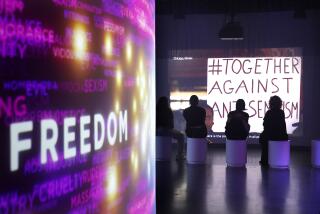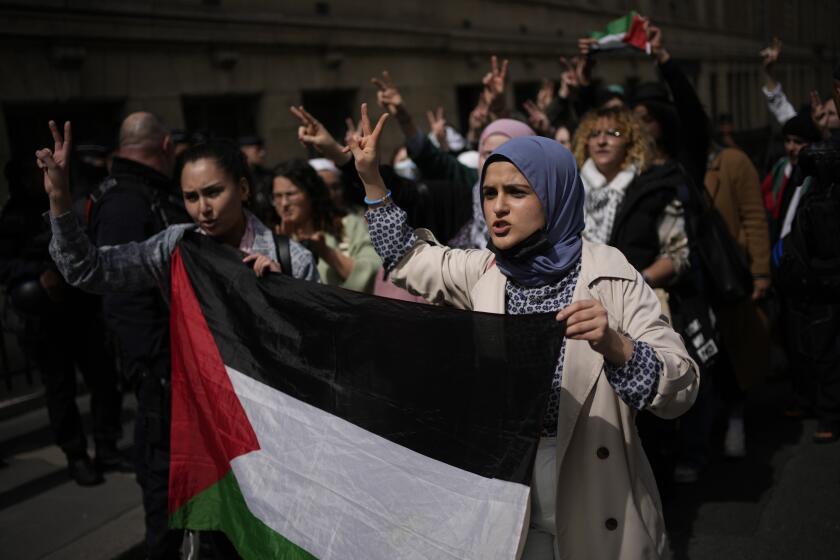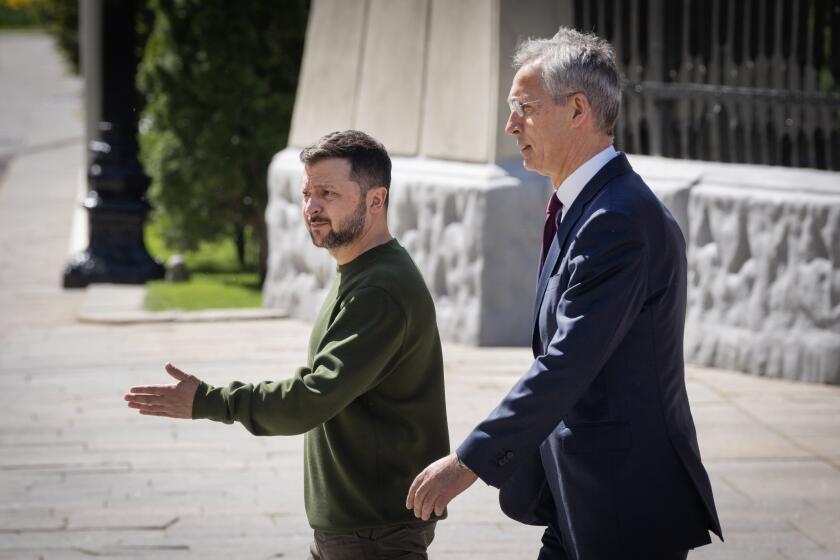Fading memories at Florence and Normandie
Just a mention of the word throws off James Oh, as if you’ve come looking for someone who moved out long ago.
“Riots here?” he says, pointing to his store, Tom’s Liquor. “No, no. Riots long, long time ago.”
Today, the shelves are neatly stocked, the floors are sparkling clean and marigold daisies blossom in the sun a few feet from his door. On the walls outside: “No graffiti at all,” he says proudly.
Twenty years ago today, when Oh was in Germany clearing minefields for the Army, one of the nation’s worst riots exploded in Los Angeles. Tom’s Liquor, at the corner of Florence and Normandie avenues, was ground zero. Its looted beer and malt liquor fueled outrage at the intersection where white truck driver Reginald Denny was infamously beaten.
The youths who now dash in and out of the green-roofed building for chips and sodas bear only the faintest connection to those days. And many of the neighbors who lived through the violence have moved out or died or simply don’t care to keep harping about the past.
But history’s a tough thing to escape at Florence and Normandie.
Every April, as surely as the faithful flock to church for Easter, TV cameras descend on this corner to remind the world about the time when buildings burned, more than 50 people died and thousands were injured.
On a recent day outside Tom’s, a woman known to all as Lil’ Momma had had enough with the attention. She grabbed a reporter’s notebook and ran off with it. Angrily, she raised a fist toward the intersection:
“Florence and Normandie, Florence and Normandie! What about Florence and Normandie? When are y’all just gonna drop it and leave us the hell alone?”
::
Oh knew little about Tom’s Liquor when he and a few Korean investors took over two years ago.
He had heard only vaguely about the Rodney King beating, the police trial and the riots; about the previous Asian owners, whose relationship with the black clientele had always been, at best, lukewarm.
But if anyone tried to warn Oh with specifics, he didn’t care to hear them.
“I don’t focus on past,” he says from behind the counter. “This is a different place now, and I am different person.”
He installed bright lights to make the store seem more open. He filled shelves with family-friendly products, such as baby bottles, diapers and detergent. And by the register, for everyone to see, he put a framed portrait of himself, smiling big in his decorated Army uniform.
“I tell everybody who comes in here, ‘Bring it on!’” the 62-year-old says, at ease in his new uniform: long camouflage shorts, a T-shirt and tennis shoes. “I trust my customers. I don’t stare at them when they shop. I don’t look at their clothes or where they have their hands. I don’t argue if they don’t have exact change. I just say, ‘OK, you pay me next time, OK?’ and I smile.”
The respect he’s earned shows as women flash him grins and men pat him on the back. They greet him with a loud ‘Hey, Sarge!” or a “How you doin’, Bring It On!”
“How you doin’, homie?” Oh hollers back.
Despite the good vibes, people sometimes snap.
So Oh and his crew ring up purchases from behind a bullet-proof screen. At the entrance, a security guard stands by, Mace strapped to his belt. And on the graffiti-free walls outside, sign after sign warns that the premises are monitored by cameras and police.
::
Senior Lead Officer Martin Martinez swings by regularly as he cruises the streets of the LAPD’s 77th Division.
The veteran of 26 years was on duty the night the riots began; he helped rescue a pregnant woman who was dragged from her car and stabbed in front of her husband.
He’s seen the area go from 73% black to more than half Latino in the last two decades.
Stores catering to Central Americans stretch for miles down Florence: Rosa’s Party Supply, Hilda’s Beauty Salon, Don Panchos 99 Cent.
At the Auto Zone on the corner, a mix of blacks and Latinos shop, but it’s Latinos who run the registers.
Children grow up on the same playground, but they go to separate day cares, separate hair salons and separate churches.
“Mostly, people are very tolerant of each other,” Martinez says.
When they do clash, he says it has little to do with race.
“It’s more about the language barrier or nuisances like illegal vending on the streets.”
When Maria Soto, 60, moved into the neighborhood 14 years ago, she learned the best thing she could do was mind her business.
“No matter what I see, no matter what I hear, I don’t get involved,” the Salvadoran immigrant says.
The 11 square miles Martinez patrols are full of contrasts:
Homicides and drive-bys have dropped dramatically, but danger still fills his radio airwaves: Nine shots fired from a rooftop at 83rd and Wadsworth. People running. Fifteen shots heard near 75th. Man fled scene.
The local Boys and Girls Club has quadrupled in size, offering 300 kids each day a friendly space to play and do their homework. Still, census figures show less than half the neighborhood makes it out of high school.
Big retail has brought new life — a Home Depot, a Jamba Juice, an IHOP — to some intersections. But in other places where businesses burned, all that flourishes are weeds and litter.
“They were supposed to build a mall here, a huge one that took up this whole corridor,” says Martinez, driving south on Vermont. “But for some reason, it never came.”
The project had to be abandoned by the city because of an uncooperative land owner and budget issues, said current Councilman Bernard Parks.
One major change Martinez sees is that the neighborhood is far more willing to talk to police.
“We’re more transparent and they’re not as afraid,” Martinez says.
As he spotted a few old folks loitering on lawn chairs near a market, a whistle was all it took to get them moving. They grabbed their chairs, waved in his direction and walked off.
“Appreciate it, Pops!” Martinez hollered out his window.
::
On 71st Street, one block north of Florence and Normandie, Georgiana Williams never needed more than her stink eye to command attention. Everyone knew her as “Grandma” — and when Grandma gave the boys the stare, they listened.
A deeply religious woman, she had moved from Mississippi to California hoping for a better life. She worked long hours as a nurse, and back in the 1980s and ‘90s she fed, clothed and housed many of the young men who grew up on her block. That included her son, Damian.
Still, as hard as she tried, she could not keep the young men out of trouble.
The evening Reginald Denny was pulled from his truck as he drove through Florence and Normandie, Damian appeared on the video, taking part in the attack.
Williams vehemently defended her son. That couldn’t have been him in the video.
“He doesn’t look like that,” she told anyone who would listen. “I say they don’t know who was at Florence and Normandie.”
Damian served four years for the beating. After his release, Williams moved the family to an apartment in Compton to keep her son away from the block and from police, who she believed were after Damian for his involvement in the riots.
But her son didn’t stay away for long. In 2000, he was arrested on suspicion of participating in the killing of man at a drug house near 71st Street. He’s serving 30 years to life.
Today, Georgiana Williams lives 60 miles east, in Fontana. She stays there with her daughter.
But at least once a month, she’s back on 71st, walking stick in hand, hollering the names of the few neighbors who remain.
If she catches men huddled on the sidewalk, drinking or smoking weed, she makes them pour out the liquor and stomp out the joint, then sends them home.
“I know all their mamas, and all their mamas know me,” she says.
On a recent Saturday, she moved slowly up the block, past stucco homes with neat yards guarded by tall iron fences. Her limbs ached and her long lavender dress was sticky from the heat, but she had a 20th anniversary block party to plan and still needed signatures from three neighbors.
“Dorothy! Dorothy!” she yells outside a faded mint house with a rose bush out front. “It’s Georgiana. Come to the door! It’s hot out here!”
A young girl appeared on the porch. “My grandma’s in Vegas,” she says.
“Veeh-gas!” Williams teases. “Well, tell her I’ll be back on Monday.”
She’s organized a neighborhood gathering nearly every year to mark the anniversary of the riots, or, as she likes to call it, “The Rebellion.”
It’s her way of letting the neighborhood speak for itself, about the police brutality that existed back then and the way she believes her son and other young men who rioted were unfairly targeted by the media.
“Today we still need jobs, we still need books in schools, we still going to prison, we still struggling,” she says.
This year’s block party, with music, political speakers, anniversary T-shirts and her coveted peach cobbler and corn bread, will probably be her last.
At 72, Williams plans to move to Chicago to launch a street ministry.
She couldn’t save her son, but perhaps she will save others.
“I’m gonna get myself a loudspeaker,” she says. “Go to the streets and tell them all about the Bible.”
::
There were some, like Todd Sellers, who didn’t stick around for long after the riots. In 1994 he headed east, like thousands of other African Americans, to start anew in the suburbs of the Inland Empire.
The 28-year-old had gangbanged, sold drugs, done time. The day of the riots, as his mother, Hazel, prayed for the sirens to stop, Sellers dressed and walked to the corner of Florence and Normandie to take in all the action.
Days later, he was featured on a “Nightline” special with Ted Koppel.
Sellers and his gangster friends took the anchor on a stroll of the intersection, a mangled junkyard of metal and ashes. They answered his questions with the brashness of young black men who were done being oppressed.
“In ’65 we didn’t have assault rifles, Uzis, hand grenades, bullet-proof vests,” Sellers said to the camera, referring to the Watts riots. “Now we do. It’s a whole new generation out here.”
Out in the Inland Empire, Sellers created a new identity for himself. He worked long days collecting waste water for the city of L.A. He steered clear of the police and told his kids to study hard.
Fifteen years went by, away from the ‘hood.
Then he was diagnosed with pancreatic cancer. He was in and out of the hospital and could no longer work. Hazel persuaded him to move back to her home on 74th Street so she could care for him.
The decision was not easy. Sellers’ first two children were grown, but his third, a son named Joseph, was only 13.
Joseph was a good kid, a skateboarder who knew little about gangs or South L.A.
“I didn’t want him to get caught up,” Sellers says. “I had done enough damage for everybody already.”
Bedridden most days, Sellers did what he could to counsel his son, to teach him what to avoid on the streets.
“I’d tell him, ‘You see those guys pushing grocery carts and smoking cigarettes? You don’t want to end up like them. You want to fit in with fresh haircuts, a good job and a college degree.’”
Today, Joseph is 16. He goes to Washington High School, the same one Sellers attended.
At 6 feet tall and more than 200 pounds, the boy would be intimidating as a gangster or a football player, but Joseph has no time for that. He’s too busy studying — and skateboarding.
Dressed head to toe in skater brands, he practices each week day with friends and attends competitions on weekends. Not long ago, a local skateboarding shop decided to sponsor him.
“They give me free boards, free hats and free stickers,” Joseph says proudly.
One day, he wants to turn pro.
And Sellers, whose cancer is in remission, is willing to do anything to help him. The 46-year-old father is teased around the neighborhood sometimes.
“They tell me, ‘Your boy a white boy,’” Sellers says, sitting on his mother’s porch. “But it’s no big deal. This is what he’s fallen in love with and I know he’s going places with it — places I could never go as a kid.”
esmeralda.bermudez@latimes.com
One in a series of stories about the 1992 riots and how they reshaped Southern California.
More to Read
Start your day right
Sign up for Essential California for news, features and recommendations from the L.A. Times and beyond in your inbox six days a week.
You may occasionally receive promotional content from the Los Angeles Times.







